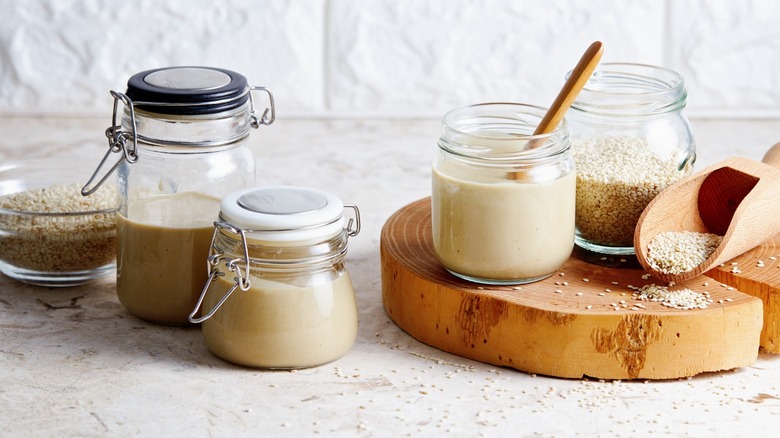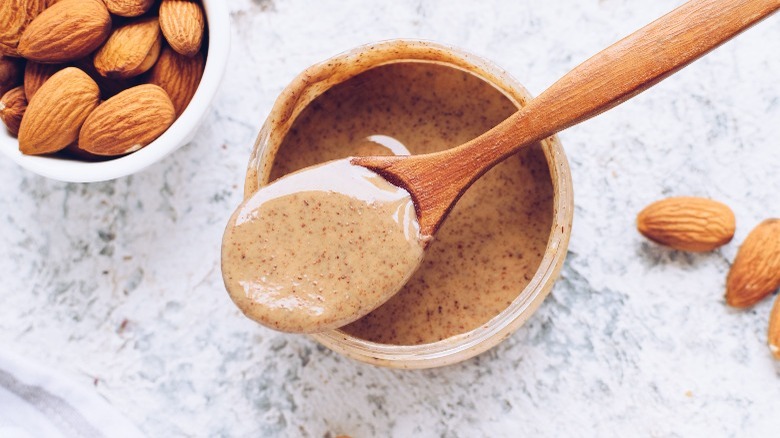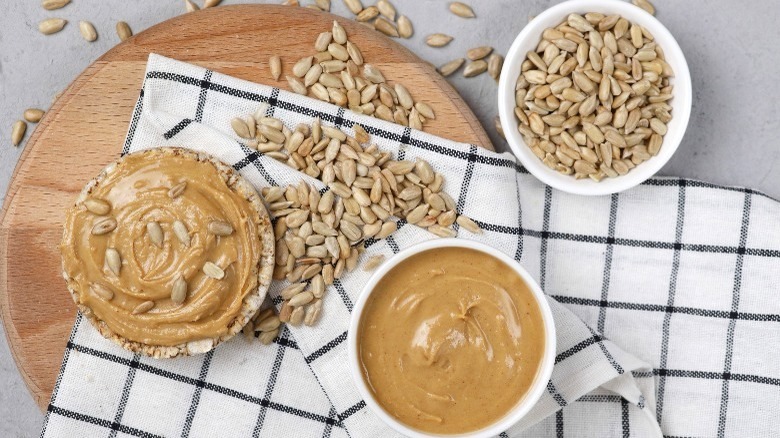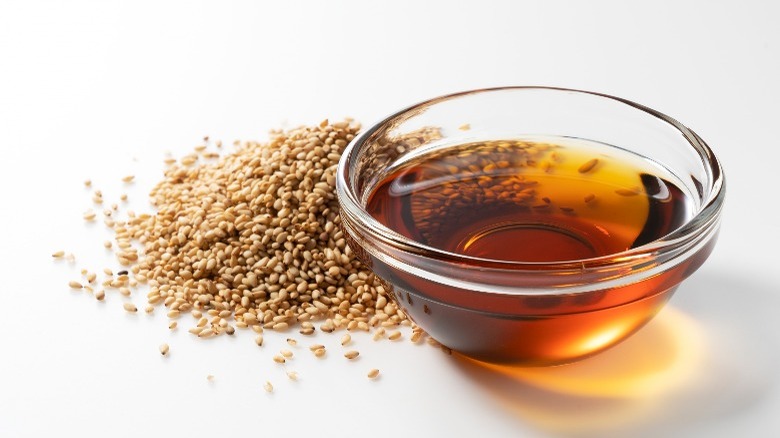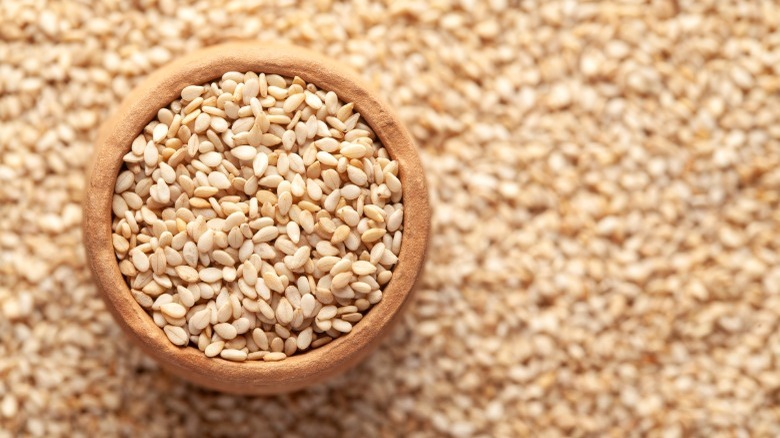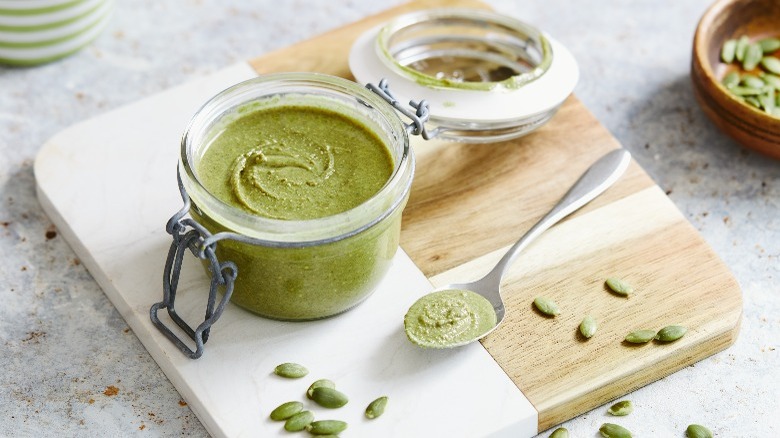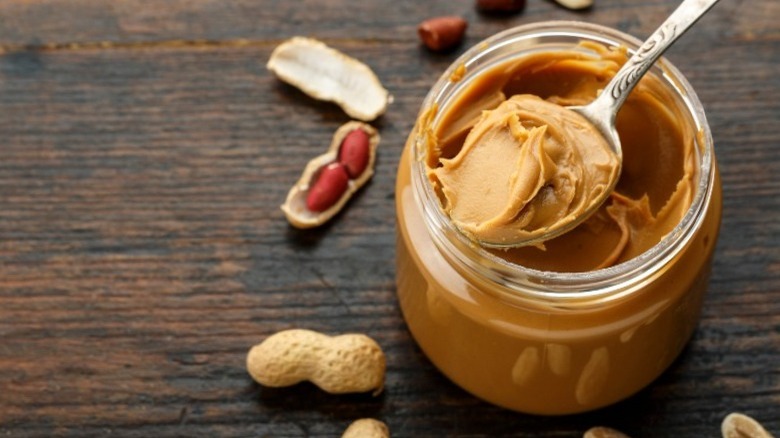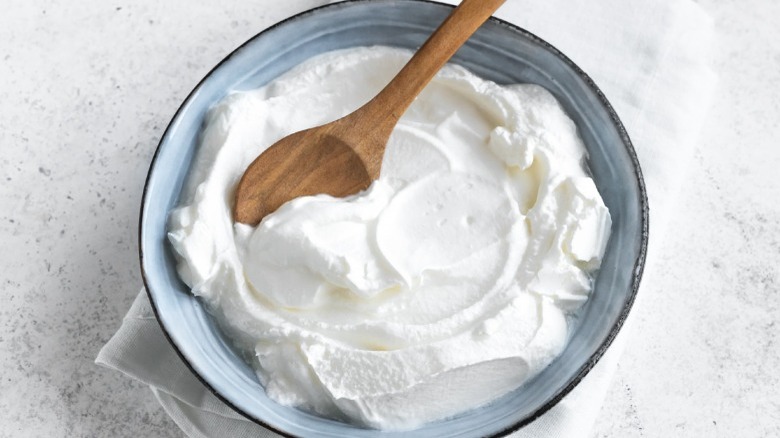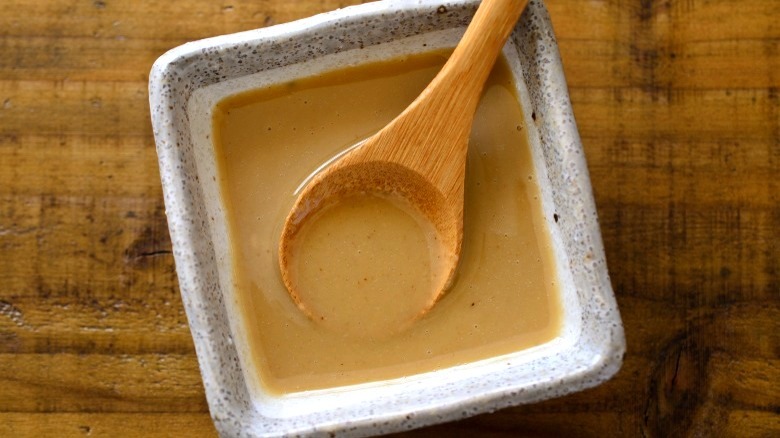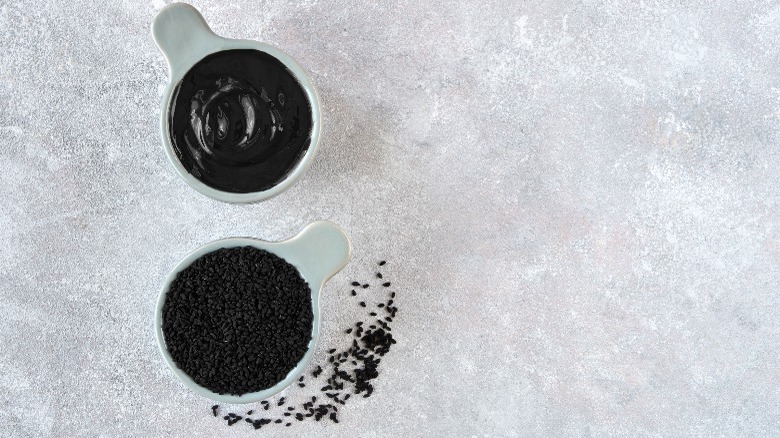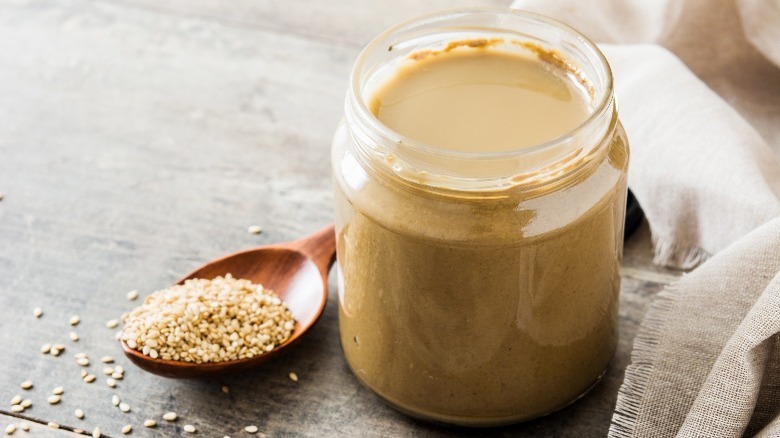The 10 Absolute Best Substitutes For Tahini
Renowned for its glossy, creamy texture and mild yet rich earthy flavor, tahini has slowly grown in popularity over the past decade in restaurant and home kitchens all over the world. However, in its native Middle Eastern cuisines, it's been used for centuries. It's the key ingredient in signature dishes such as hummus, halva, and baba ganoush. These days, however, the sesame paste is being incorporated into various dishes, including cookies and ice cream, hearty soups, pasta sauces, and more. But what happens when you get excited to try one of those recipes and find yourself out of tahini? There are two solutions: skip it or replace it with one of the handy substitutes available.
While there isn't one ideal substitute for tahini, there is always a way to make it work. Keep in mind that the replacements vary in structure and flavor; some are a closer match than others, depending on what the recipe calls for. Before picking a substitute, try imagining your dish's desired flavor profile and texture. Does it call for something tangy, slightly bitter, or, rather, for that signature nutty flavor of sesame? Will it be a creamy dip, a baked treat, or a topping for toast? What's the desired color palette of your future creation? Answering these questions and browsing through our options will help you strike a balance when picking the best tahini substitute. Additionally, remember to ask yourself whether you or anyone who will taste your dish has any allergies and choose a tahini substitute wisely, since sesame seeds, peanuts, and tree nuts make up over a third of food allergies in the U.S. (via FARE).
Cashew or almond butter
There's a reason these two types of nut butter are the most common tahini substitutes. First, cashew and almond butter have a similarly smooth and creamy consistency, yet they taste delicate and unobtrusive. Naturally, both flavor profiles are on the nuttier side, which works best in milkshakes or desserts in place of tahini. They could also lend creaminess to savory dishes and are ideally suited to be drizzled over veggies. To substitute tahini with either, aim for a 1-to-1 ratio and adjust to taste from there on out.
Although almond and cashew butter seem similar, there are reasons to lean towards one rather than the other. First, while making your own cashew butter could cut costs, the store-bought version is pricier than almond butter, so the latter is a more budget-friendly tahini substitute. Additionally, almond butter has less sodium and saturated fat than both tahini and cashew butter (via Foodstruct), so if that's something you're trying to avoid in your diet, almond butter is the way to go.
Sunflower seed butter
This tahini substitute is perfect for those with a nut or sesame allergy (and that's about 10.7 million Americans, according to FARE). Sunflower seed butter is a healthy source of plant protein, and is packed with vitamins and minerals, particularly, vitamin E — one tablespoon provides almost 25% of the recommended daily intake (via Cedars Sinai).
One way to experiment with replacing tahini with sunflower seed butter would be to make halva — a Middle Eastern fudgy treat most often made with tahini. A variation made from sunflower seeds also exists and is popular in Eastern Europe, since, over there, it's a more established crop than sesame (via Folkways). We recommend taking a tahini halva recipe and replacing the namesake ingredient with sunflower seed butter. Additionally, its consistency is thicker and more spreadable than that of tahini, so you can get in on the tahini toast craze with an allergen-free twist. Or if you're substituting in a savory recipe, make sure your sunflower seed butter is sugar-free and thin it out with some sesame or olive oil, if necessary.
Sesame oil
If the reason you're trying to substitute tahini is not related to a sesame allergy, then this could be the replacement for you. If you happen to have sesame oil (regular or toasted) in the pantry, it will work well in place of tahini for certain dishes. Sesame seeds, which, according to The Washington Post, have about half their weight in oil, are often the only ingredient in store-bought tahini, so sesame oil is already part of it! It's the liquid that separates from the sesame paste if you let your tahini sit for a while.
Naturally, both have a very similar earthy, nutty flavor profile, which could make tahini and sesame oil interchangeable in recipes that are playing off of that signature flavor. When it comes to texture, however, it's important to remember that tahini is a paste, even if it's runny and part of it is oil. Therefore, you likely won't be able to replace it with sesame oil in a recipe where tahini would be used to provide a thick and creamy texture, like a lemon tahini dressing. It would, however, make a viable substitution in a hummus recipe since chickpeas give the dip its texture. Plus, you'll likely need half the amount or less because it's fattier and more liquid, so sesame oil could also make a budget-friendly tahini substitute. Finally, mixing a bit of sesame oil with a nut or seed butter could provide the best of both worlds, providing a creamy texture and signature sesame flavor.
Sesame seeds
Sesame seeds are an ancient nutritional powerhouse. They've been around for at least 5000 years and have many culinary uses of their own that go beyond being sprinkled over bread (via Britannica). Similarly to sesame oil, they are the closest flavor match for tahini, because they are its main (and often only) ingredient. So if a recipe calls for a small amount of tahini as a finishing touch, a simple solution would be to use sesame seeds in its place. While it might be tempting to skip tahini altogether if only a couple of tablespoons is required, using sesame seeds will not only deepen the flavor of your dish and add a fun crunchy texture, but also improve its nutritional value. According to Healthline, a 3-tablespoon serving of sesame seeds contains 5 grams of protein, and 3½ grams of fiber, which makes up for 12% of the recommended daily intake, in addition to high zinc, calcium, manganese, and magnesium content. Depending on the desired flavor profile, you could use raw or toasted sesame seeds but bear in mind that toasted ones bear more resemblance to tahini. If you only have raw sesame seeds on hand, it's easy to toast them yourself on a dry skillet for a couple of minutes over medium heat until golden.
Pumpkin seed butter
Pumpkin seed butter is another allergy-friendly tahini substitute. As the name suggests, it's made from deshelled pumpkin seeds, commonly known as pepitas. It has a consistently creamy texture, as the oil doesn't really separate from the solids as much as in other kinds of nut and seed butter (via Superfoodly).
One reason to try it would be its health benefits. Compared to tahini and the other substitutes mentioned so far, pumpkin seed butter has the most protein. Additionally, one tablespoon of it contains 23% of the recommended daily intake of iron, 18% magnesium, and 15% phosphorus (via Eat This Much). In addition, pumpkin seeds are rich in phytosterols, which are plant-derived nutrients able to lower the LDL, or "bad" cholesterol (via NutritionFacts.org). It also generally matches tahini's price point, so using it as a substitute won't break the bank. When replacing tahini with pumpkin seed butter, make sure to use an unsweetened organic variety, as its green color and slight bitterness make it an organic replacement for tahini in pesto.
Peanut butter
Peanut butter makes for an affordable and practical tahini substitute among nut butters since you're likely to already have it on hand. In some recipes, tahini and peanut butter could easily be switched. Use the smooth and creamy varieties for best results when baking, or if you're going in a different direction, mix it with a bit of sesame oil to alter the flavor and texture to mimic tahini in savory dishes (including hummus).
Suppose that a mere idea of a peanut butter hummus as a shock to you. In that case, you should know that celebrity chefs like Nigella Lawson and Jamie Oliver swear by adding peanut butter to hummus instead of tahini. The flavor is likely not authentic, as peanut butter has a strong and particular taste, but this approach yields the same creamy results and makes the whole ordeal easier on the wallet. So if you're not a hummus purist, we encourage you to try this tahini swap!
Greek yogurt
While Greek yogurt might not be close to the toasty sesame paste in terms of flavor since it brings more of a tang to the plate, its thick, creamy consistency matches that of tahini while being less calorie-dense. A yogurt-tahini combination is common in Mediterranean and Middle Eastern cuisines and the recipes they inspire. Therefore, if you're planning to make a tahini goddess dip recipe, which uses equal amounts of Greek yogurt and tahini, you could replace the tahini with yogurt in a 1-to-1 ratio.
Of course, the result will be far tangier and not as viscous, but we're sure a crudités platter can handle this upgrade. For the adventurous home cooks, there's even a rule-breaking black-eyed-pea hummus recipe that uses Greek yogurt instead of tahini, so feel free to experiment with substituting one for the other in recipes that rely on tahini's creaminess, like sauces, dips, or spreads. If you'd like to keep your tahini recipes plant-based, use a vegan Greek yogurt alternative.
Chinese sesame paste
Believe it or not, tahini isn't the only sesame paste out there. Sesame has been cultivated worldwide for ages and has been particularly appreciated in Chinese culture and cuisine since antiquity. Today, China is one of the biggest producers and importers of sesame in the world, according to FAO. Needless to say, sesame seeds and products derived from them are used extensively. One example would be zhi ma jiang — a Chinese-style sesame paste.
Even though both tahini and zhi ma jiang are made from sesame seeds, they aren't quite suited for 1-to-1 substitutions. While tahini is traditionally made with hulled, raw (or very lightly toasted) sesame seeds, its Chinese counterpart uses toasted whole sesame seeds as its base, resulting in a darker color and more intense flavor. You probably shouldn't try to add it to hummus or other classic Middle Eastern and Mediterranean dishes. The two could, however, be interchangeable in some recipes. The boost of umami and the creamy texture Chinese sesame paste brings to the plate would be greatly appreciated in Asian-inspired sauces or hearty soups like a vegan miso ramen.
Black sesame paste
A staple in Japanese cuisine, where it is known as kuro neri goma, black sesame paste is used in a variety of sweet and savory dishes in different counties across Asia. Also called "black tahini" in English, it's a thick paste made from ground black sesame seeds, sometimes sweetened with sugar or honey. It boasts delectable nuttiness and a velvety, creamy texture, and its rich color and flavor surpass those of tahini.
Unfortunately, due to its intense jet-black hue, it wouldn't be a great addition to the cream-colored dishes traditionally made with tahini (although you could save the black hummus idea for next Halloween). But it could work well in recipes that rely on the tahini-chocolate pairing. If you've never tried mixing sesame and chocolate, you definitely need to: Think of all the brownies, ice cream, fudge, and cakes it could take to the next level! One way to try this combo would be to whip up a batch of these gluten-free chocolate tahini cookies and replace the tahini with black sesame paste if you're feeling adventurous. Of course, any recipe requiring food dye could also be attempted with black tahini.
Homemade tahini
If you've been a fan of Middle Eastern cuisine for over a decade, you probably have attempted to make your own tahini before, seeing as it only became widely available in U.S. supermarkets in the mid-2010s (via Forbes). It could have been a success, or it could have been a disaster, depending on what equipment you used and how much patience you had. These days, you can easily pick tahini up at the store or order online to save yourself the hassle.
But if you ever find yourself in a situation where an overwhelming desire to cook with tahini clashes with no chance of buying it, sesame seeds and a powerful kitchen processor are there to help you out. You might even enjoy having more control over the flavor and consistency, as well as knowing it's fresh, unlike the stale and hard store-bought tahini we sometimes encounter. An easy two-ingredient homemade tahini recipe would be a great place to start. Start by toasting sesame seeds and then add them to a food processor. Drizzle in some olive oil and blend (up to 15 minutes) until creamy.
